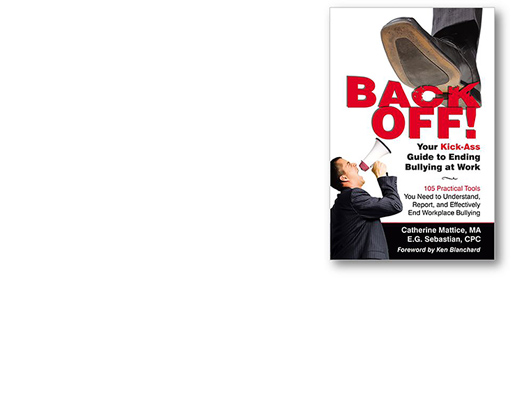If you’re being bullied, you know it is complicated. It’s hard to understand why you’re being bullied, why managers won’t help, and what to do about it. And it’s hard for others to understand what you’re really going through unless they’ve been bullied themselves.
Excerpted from our book, BACK OFF! Your Kick-Ass Guide to Bullying at Work, here are the six concepts central to the workplace bullying phenomenon. Use them to describe bullying to your support system and your managers.
#1: Bullying is recurring, perpetual, and ongoing
If a person yells at you once or twice, this is impolite or perhaps uncivil, but it’s probably not going to affect you very much over the long run. Bullying occurs when aggressive behaviors occur regularly and consistently, with no signs of improvement. Many researchers hesitate to call something bullying unless the behaviors are happening several times a week for a period of six months. We think, however, that if the behavior is consistent and your co-worker or boss shows no sign of relenting, then bullying is happening. You don’t have to wait six months before you can officially say, “I’m being bullied.”
#2: Bullying escalates in frequency and level of aggression over time
Sometimes co-workers can be a little mean, but if the rudeness never escalates beyond that, or doesn’t get worse or more frequent as time goes on, then that person is just ill-mannered. And while annoying, perhaps you can take comfort in the fact that they are simply socially inept, and not out to make your life miserable. Bullying, on the other hand, becomes more frequent and more aggressive as time goes on.
#3: Bullying causes psychological harm to targets and witnesses
Bullying can be really hurtful. But you already know this.
We want to highlight, however, that witnesses are also affected by the workplace bullying. Even if someone doesn’t feel like they are targeted, observing bullying behaviors is harmful to their mental psyche. In addition, witnesses live in a state of fear that they will be targeted next.
#4: Bullying is about power
The first time a person becomes aggressive with you, if you do not immediately become assertive and stand up for your rights, that person will continue to bully you because you have, in essence, given the green light that you will “take it.” From the start of this first incident, the aggressor has power. Over time, as the bullying continues, the relationship between the bully and target becomes one of an unfair and unhealthy power imbalance. The perpetrator understands that he or she has power over the target, and the target believes the perpetrator indeed has that power and is unable to stand up against it.
Incidentally, the power imbalance between bully and target need not be formal. Approximately 70% of bullies bully subordinates, but that means 30% of bullies are bullying their peers or superiors. Interestingly, when people do bully “up,” or bully their managers or superiors, the bullying behavior seems to be more aggressive than when bullying “down” or bullying a subordinate.
#5: Bullying causes communication breakdown among employees and managers
When bullying is allowed to happen at work, both targets and witnesses are afraid. Everyone, whether bullied or not, fears the next outburst or act of aggression, and this creates a chain of undesired effects. Targets and witnesses will try to stay out of the way of the bully and might be afraid to ask for the information necessary to properly complete their job tasks. For example, if a target needs an answer to a question, and the bullying manager has the answer, the target will dread approaching that manager and will likely never obtain the answer to his or her question. This means that any employee fearing that manager is not getting the information he or she needs to do the job right.
In addition, as we describe below in our list of bullying behaviors, bullies often use communication as a way to gain power over an individual, or purposefully sabotage work. The bully might, for example, purposefully omit the target from staff meetings in order to keep the target out of the loop. If the target is not at the meeting, but holds information that can further the group’s goals, the entire group suffers as a result of this bullying tactic.
When these elements are present, this results in hindering the organizations’ ability to provide excellent products and services to their customers, follow safety protocols, maximize performance, and maintain competitiveness, to name a few of the problems bullying creates.
#6: Organizational goals cannot be met when there’s a bully, and the bottom line suffers
Communication among employees and their managers is paramount to an organization’s success. If team members can’t communicate, they can’t meet their individual goals, and the organization can’t meet its goals either. It’s simple: anytime an organization allows suppression of communication, abusive behaviors, and unhealthy relationships to foster, it sets itself up for failure. Goals are not met in a timely manner and the bottom line suffers.

